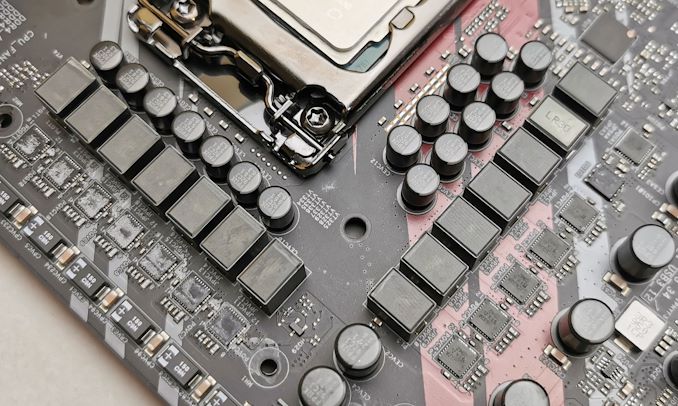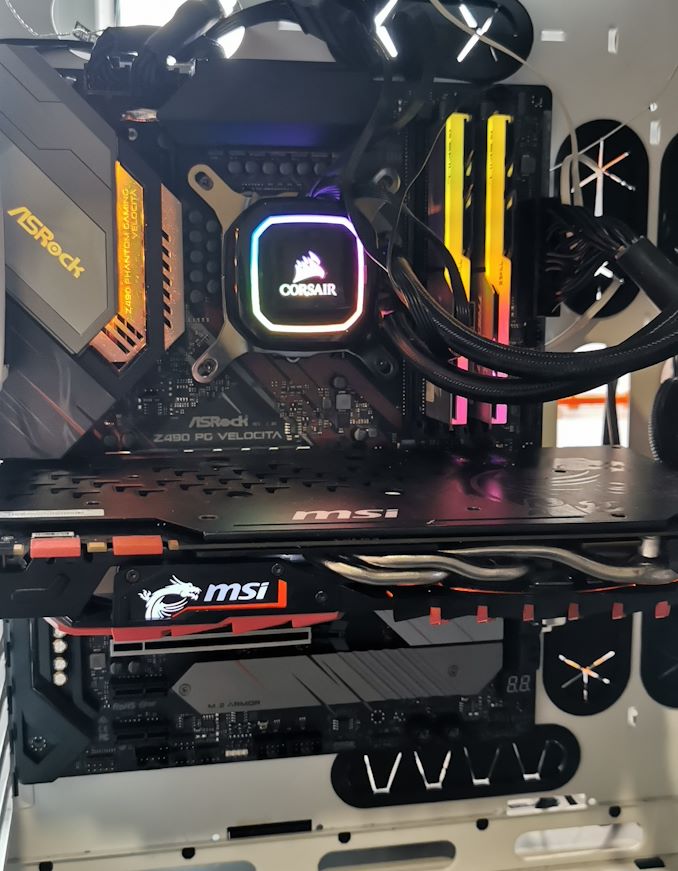The ASRock Z490 PG Velocita Motherboard Review: It Means SPEED
by Gavin Bonshor on September 21, 2020 9:00 AM ESTPower Delivery Thermal Analysis
A lot more focus has been put onto power delivery specifications and capabilities, not just by manufacturers, but as a result of users demands. In addition to the extra power benefits from things like overclocking, more efficient designs in power deliveries and cooling solutions aim to bring temperatures down. Although this isn't something most users ever need to worry about, certain enthusiasts are bringing more focus onto each boards power delivery. The more premium models tend to include bigger and higher-grade power deliveries, with bigger and more intricate heatsink designs, with some even providing water blocks on ranges such as the ASUS ROG Maximus Formula series.

The 10+2+1 power delivery on the ASRock Z490 PG Velocita
Testing Methodology
Our method of testing out if the power delivery and its heatsink are effective at dissipating heat, is by running an intensely heavy CPU workload for a prolonged method of time. We apply an overclock which is deemed safe and at the maximum that the silicon on our testbed processor allows. We then run the Prime95 with AVX2 enabled under a torture test for an hour at the maximum stable overclock we can which puts insane pressure on the processor. We collect our data via three different methods which include the following:
- Taking a thermal image from a birds-eye view after an hour with a Flir Pro thermal imaging camera
- Securing two probes on to the rear of the PCB, right underneath CPU VCore section of the power delivery for better parity in case a probe reports a faulty reading
- Taking a reading of the VRM temperature from the sensor reading within the HWInfo monitoring application
The reason for using three different methods is that some sensors can read inaccurate temperatures, which can give very erratic results for users looking to gauge whether an overclock is too much pressure for the power delivery handle. With using a probe on the rear, it can also show the efficiency of the power stages and heatsinks as a wide margin between the probe and sensor temperature can show that the heatsink is dissipating heat and that the design is working, or that the internal sensor is massively wrong. To ensure our probe was accurate before testing, I binned 10 and selected the most accurate (within 1c of the actual temperature) for better parity in our testing.
To recreate a real-world testing scenario, the system is built into a conventional desktop chassis which is widely available. This is to show and alleviate issues when testing on open testbeds which we have done previously, which allows natural airflow to flow over the power delivery heatsinks. It provides a better comparison for the end-user and allows us to mitigate issues where heatsinks have been designed with airflow in mind, and those that have not. The idea of a heatsink is to allow effective dissipation of heat and not act as an insulator, with much more focus from consumers over the last couple of years on power delivery componentry and performance than in previous years.

ASRock Z490 PG Velocita undergoing our VRM thermal testing (we close the side panel when testing)
For thermal image, we use a Flir One camera as it gives a good indication of where the heat is generated around the socket area, as some designs use different configurations and an evenly spread power delivery with good components will usually generate less heat. Manufacturers who use inefficient heatsinks and cheap out on power delivery components should run hotter than those who have invested. Of course, a $700 flagship motherboard is likely to outperform a cheaper $100 model under the same testing conditions, but it is still worth testing to see which vendors are doing things correctly.
Thermal Analysis Results

We measured 50.7°C on the hottest part of the PCB around the power delivery
The ASRock Z490 PG Velocita is using a 13-phase power delivery with a 10+2+1 configuration. This is split into ten for the Vishay SiC653 50 A power stages for the CPU, two SiC654 power stages for the SoC, with the final SiC632 power stage powering the board's VCCSA. Cooling the power delivery is a pair of aluminum heatsinks that are connected by a single heat pipe, with three small cooling fans designed to increase the amount of heat that can be dissipated.
In regards to the board's power delivery thermal performance, the 10+1+1 design works well and due to the active cooling of the heatsinks, the PG Velocita is a solid performer. The difference between our recorded temperatures from the pair of K-Type Thermocouples and the integrated temperature sensor was minimum, with just one to two degrees of variance. We recorded a temperature of 53°C from the integrated sensor which sits middle of the pack compared with other boards we have tested. The ASRock Z490 PG Velocita is a solid performer and the active cooling solution for the power delivery works well, but the fans can spin quite fast and they aren't the quietest. The fans can be altered within the firmware with less aggressive settings, although ASRock patched the firmware from earlier revisions where the fans would make the system sound like a jet engine.











16 Comments
View All Comments
Chaitanya - Monday, September 21, 2020 - link
Yay, one more example of lazy engineering: slapping multiple tiny fans with proprietary connectors on VRM heatsoak and calling it a day.rahvin - Monday, September 21, 2020 - link
Why would you test non-UEFI boot times? Is anyone still using legacy Bios?JanW1 - Tuesday, September 22, 2020 - link
That title makes me wanna stop reading Anandtech. How stupid is that for a motherboard review !? This wouldn't even be good marketing, it just sounds immature. As others have pointed out, speed is not a main reason for MB buying decisions, design, build quality and reliability is.PeachNCream - Tuesday, September 22, 2020 - link
While I can imagine the quality of tiny fans has improved significantly over the years, I would still not want anything to do with a motherboard festooned with three of them. There are lots and lots of alternatives at all sorts of price points that do not have or require active cooling of any sort.Archer_Legend - Friday, September 25, 2020 - link
There are several mistakes in the article, as you can see on the box it is written velocità not velocita.javedhashmi - Tuesday, October 13, 2020 - link
Driver Booster Pro Crack is a free driver updater program for Windows that can automatically check for outdated drivers for your hardware on a routine basis, and even download and update all the drivers with one click. The Latest Driver Booster PRO still continues to provide consistency and reliability for those who need to identify and update their drivers. Maintaining a straightforward layout and intuitive features, is now adds several little tweaks, which can make a significant difference.https://crackreview.com/driver-booster-pro-crack/